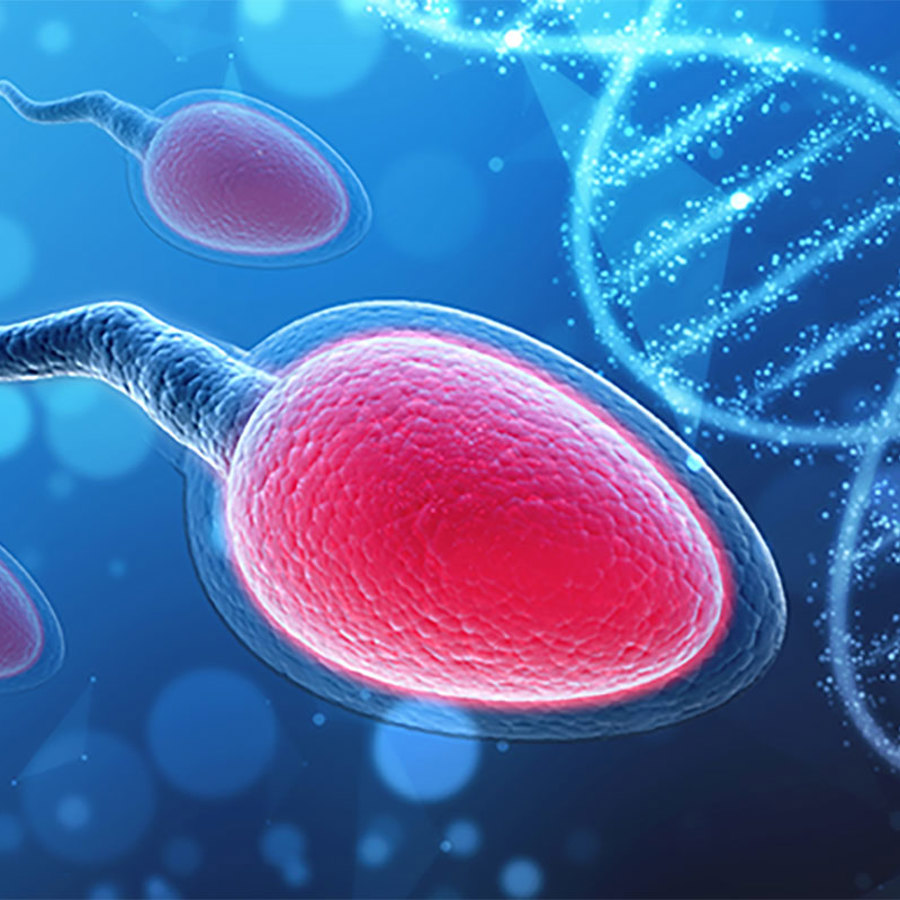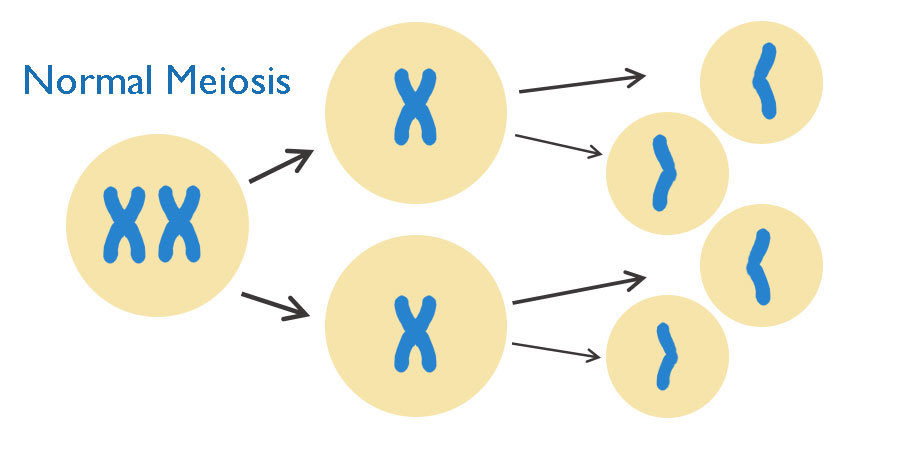
How do age and environment impact the genetics of sperm?
August 2, 2011

- Related Topics:
- Aging,
- Mutation,
- Reproduction,
- Meiosis,
- Developmental biology
A curious adult from Australia asks:
“If women are born with all the eggs they will ever use and men create sperm as they need it, will the genetics of the sperm change due to variables like the environment, age or personality changes?”
Excellent question! In some ways, you’re already on the right track. Because men make sperm all the time, their DNA can be affected by lots of different things.
For example, chemicals in the environment can damage sperm DNA. And so too can age, since just the process of making new sperm can change its DNA!
So as a man gets older, the DNA in his sperm will build up more and more changes. This is one reason why the children of older dads are at a higher risk for certain diseases that are caused by DNA changes.
However, these kinds of changes are unlikely to be caused by personality changes or other such traits. For example, if a normally calm man all of a sudden becomes angry, his sperm DNA probably won’t change as a result. Or at least it won’t cause permanent changes that could affect his children.
Of course, older dads aren’t the only risk factor for children getting genetic diseases either. Even though women are born with their lifetime supply of eggs, having an older mom is a well-known risk for certain genetic diseases, such as Down syndrome. But the reason why older dads and older moms pose risks for their children is very different.
What I want to do for the rest of this answer is to talk about why men making sperm all the time can cause changes in DNA. And I also want to discuss why this leads to the children of older dads being at a higher risk for a different set of diseases than the children of older moms.

Many Sperm, Many Mistakes
As I said previously, men keep making sperm all of the time throughout their lives, while women are born with all of their eggs. New sperm are made by cells dividing over and over again (see final section for more details on this).
Each time a cell divides, the DNA inside of it is copied or replicated. Cells are pretty good at doing this, but they aren’t perfect. Sometimes, a change or mutation can happen.
Think about cell division like the game of telephone. You know, the one where a message gets passed from person to person, and everyone looks forward to the end when the last person has to say what they think they heard out loud.
Each time the message gets whispered into the next person’s ear, there is a chance that they won’t hear it correctly. Then, they pass on an incorrect message to the next person. The more people that play the game, the more changes happen to the message.
It’s the same story for sperm and egg DNA. Every time they divide, there is a chance that their DNA is copied incorrectly.
Luckily these cells pick up fewer mistakes than the telephone players! But they do still happen.
We can think of making eggs like a telephone game with three people. Mistakes can happen but they won’t be very common.
But since sperm are being produced constantly, it is like playing telephone with a hundred, a thousand, or even a million people. Mistakes are more likely to happen, and they will build up as the message gets passed along.
So with all of that dividing, there is a higher chance for mutations to happen in sperm. And any mutations that do happen can keep building up over time.
These mistakes are usually harmless. But not always. Some mistakes can lead to genetic diseases.
The older the dad, the more times his sperm have divided. This means his sperm will have a higher chance of having mistakes and so he will have a higher chance of passing on a genetic disease to his kids.
But older moms aren’t in the clear. Even though mom’s eggs go through very few divisions, they can still have mistakes. It is just that their DNA can have a different kind of mistake than sperm DNA. And different mistakes mean different kinds of diseases.

Older eggs can have missing or extra chromosomes
Our genes are actually stored on long pieces of DNA called chromosomes. We have two copies of each chromosome, one from each parent.
As a mom gets older, there is a greater chance that her eggs will have extra or missing chromosomes. Every time an egg divides, it needs to separate each pair of chromosomes, but in older women, this doesn’t happen as well as it used to. So the children of older moms can end up with extra (or missing) chromosomes more often.
This is why the children of older moms are at a greater risk for Down syndrome. Down syndrome is caused by having an extra copy of chromosome 21. And that extra copy usually comes from mom’s egg.
This is different from the DNA changes that can happen in older men's sperm. Which is why the children of older dads are at a greater risk for a different set of diseases.

Older sperm lead to an accumulation of mutations
As I’ve already discussed, sperm can build up small changes in their DNA over time. So instead of whole chromosomes being affected, just tiny bits of them are. These DNA changes can cause different diseases than having extra or missing chromosomes can.
For example, changes in sperm DNA can lead to increased risk for diseases such as schizophrenia and autism, and many others. In fact, one disease might happen because the DNA changes make the sperm better able to fertilize an egg.
Sperm with these DNA changes can out-compete normal sperm and cause a disease called Apert’s syndrome. Older dads have more sperm with these changes, so the end result is that kids with older dads have a higher risk of getting Apert's syndrome.
It used to be that all you heard about was how risky it was for older women to have babies. But now we understand that older dads aren’t in the clear either! Scientists are beginning to uncover the ways that kids of older dads are at an increased risk for certain genetic diseases too.
Before I finish, I should note that not all DNA mutations are “bad” and disease-causing … Many have no impact on gene function or health, and some can actually be beneficial! Just look at the wonderful diversity all around you; most of it is the result of mutations!
Bonus info: Making Sperm and Eggs
This last section is for people who want to learn a few more details about how eggs and sperm are made. Enjoy!
As you may already know, most of the cells in our body have two copies of each chromosome. Each of these cells received one chromosome copy from each of our parents.
How does this happen? Well, sperm and eggs actually only have half the number of chromosomes, or half the amount of DNA as most other cells in our bodies. During fertilization, the DNA from these cells combines to create a cell that has just the right amount of DNA.
To make things a little more complicated, sperm and eggs actually first start out as cells with two copies of each chromosome, called germ cells. These precursor cells are stored in sex organs (testes and ovaries) until puberty.

Then, changes in hormone levels cause them to divide into sperm and eggs. However, the way that male and female germ cells divide is very different.
Male germ cells go through many, many cell divisions. Once puberty hits, they start to constantly divide, producing more of the same type of cell.
Every now and then, a male germ cell divides to produce a different type of cell, called a primary spermatocyte. The primary spermatocyte then divides twice to become four sperm cells.
Women are different because they are born with all of their eggs already made, as I already mentioned. Female germ cells, called primary oocytes, start dividing very early on, even before a female is born.
A few weeks before she is born, a female’s primary oocytes stop dividing and stay in a kind of “asleep” state until puberty. Then, every month, one primary oocyte re-enters the division cycle. If fertilized, it will go on to produce one mature egg and three smaller cells called polar bodies, which are eliminated.
Check out this article for even more information about the different stages of sperm and egg lifecycles!
So what does all this mean? Well, it means that eggs go through many fewer divisions than sperm. This causes different types of DNA changes in these cells, and over time that can affect the children of older dads and moms in different ways like we discussed.
Read More:
- Science Daily: An overview of how sperm quality changes with age
- NewScientist: More about why eggs aging leads to higher rates of aneuploidy
- Western Journal of Medicine: A scientific pro/con list of having children at an older age
- Science Daily: Why Apert syndrome is more common than expected

Author: Dr. Maggie Pearce
When this answer was published in 2011, Maggie was a postdoctoral fellow in the Department of Biology, studying protein quality control and neurodegeneration in Ron Kopito’s laboratory. Maggie wrote this answer while participating in the Stanford at The Tech program.
 Skip Navigation
Skip Navigation
